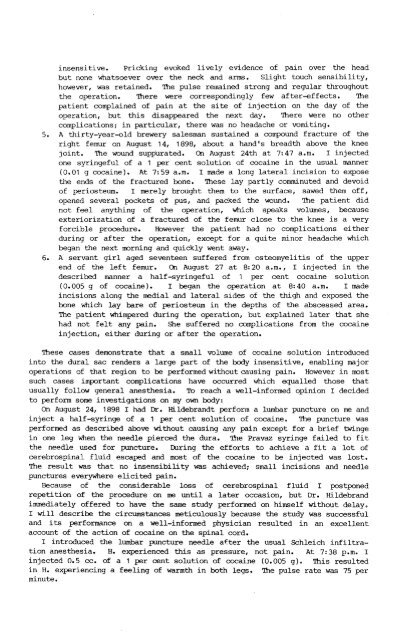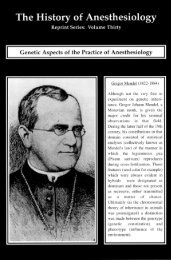Download PDF - Wood Library-Museum of Anesthesiology
Download PDF - Wood Library-Museum of Anesthesiology
Download PDF - Wood Library-Museum of Anesthesiology
Create successful ePaper yourself
Turn your PDF publications into a flip-book with our unique Google optimized e-Paper software.
insensitive. Pricking evoked lively evidence <strong>of</strong> pain over the headbut none whatsoever over the neck and arms. Slight touch sensibility,however, was retained. The pulse remained strong and regular throughoutthe operation. There were correspondingly few after-effects. Thepatient complained <strong>of</strong> pain at the site <strong>of</strong> injection on the day <strong>of</strong> theoperation, but this disappeared the next day. There were no othercomplications; in particular, there was no headache or vomiting.5. A thirty-year-old brewery salesman sustained a compound fracture <strong>of</strong> theright femur on August 14, 1898, about a hand's breadth above the kneejoint. The wound suppurated. On August 24th at 7:47 a.m. I injectedone syringeful <strong>of</strong> a 1 per cent solution <strong>of</strong> cocaine in the usual manner(0.01 g cocaine). At 7:59 a.m. I made a long lateral incision to exposethe ends <strong>of</strong> the fractured bone. These lay partly comminuted and devoid<strong>of</strong> periosteum. I merely brought them to the surface, sawed them <strong>of</strong>f,opened several pockets <strong>of</strong> pus, and packed the wound. The patient didnot feel anything <strong>of</strong> the operation, which speaks volumes, becauseexteriorization <strong>of</strong> a fractured <strong>of</strong> the femur close to the knee is a veryforcible procedure. However the patient had no complications eitherduring or after the operation, except for a quite minor headache whichbegan the next morning and quickly went away.6. A servant girl aged seventeen suffered from osteomyelitis <strong>of</strong> the upperend <strong>of</strong> the left femur. On August 27 at 8:20 a.m., I injected in thedescribed manner a half-syringeful <strong>of</strong> 1 per cent cocaine solution(0.005 g <strong>of</strong> cocaine). I began the operation at 8:40 a.m. I madeincisions along the medial and lateral sides <strong>of</strong> the thigh and exposed thebone which lay bare <strong>of</strong> periosteum in the depths <strong>of</strong> the abscessed area.The patient whimpered during the operation, but explained later that shehad not felt any pain. She suffered no complications from the cocaineinjection, either during or after the operation.These cases demonstrate that a small volume <strong>of</strong> cocaine solution introducedinto the dural sac renders a large part <strong>of</strong> the body insensitive, enabling majoroperations <strong>of</strong> that region to be performed without causing pain. However in mostsuch cases important complications have occurred which equalled those that,usually follow general anesthesia. To reach a well-informed opinion I decidedto perform some investigations on my own body:On August 24, 1898 I had Dr. Hildebrandt perform a lumbar puncture on me andinject a half-syringe <strong>of</strong> a 1 per cent solution <strong>of</strong> cocaine • The puncture wasperformed as described above without causing any pain except for a brief twingein one leg when the needle pierced the dura. The Pravaz syringe failed to fitthe needle used for puncture. During the efforts to achieve a fit a lot <strong>of</strong>cerebrospinal fluid escaped and most <strong>of</strong> the cocaine to be injected was lost.The result was that no insensibility was achieved; small incisions and needlepunctures everywhere elicited pain.Because <strong>of</strong> the considerable loss <strong>of</strong> cerebrospinal fluid I postponedrepetition <strong>of</strong> the procedure on me until a later occasion, but Dr. Hildebrandimmediately <strong>of</strong>fered to have the same study performed on himself without delayoI will describe the circumstances meticulously because the study was successfuland its performance on a well-informed physician resulted in an excellentaccount <strong>of</strong> the action <strong>of</strong> cocaine on the spinal cord.I introduced the lumbar puncture needle after the usual Schleich infiltrationanesthesia. H. experienced this as pressure, not pain. At 7:38 p.m. Iinjected 0.5 cc. <strong>of</strong> a 1 per cent solution <strong>of</strong> cocaine (0.005 g). This resultedin H. experiencing a feeling <strong>of</strong> warmth in both legs. The pulse rate was 75 perminute.
















